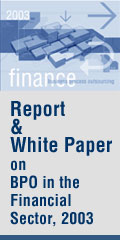|


|
India's Ratings Maintained by S&P on Growth Outlook
Standard & Poor's Ratings Services on October 31, 2008 affirmed its 'BBB-' long-term and 'A-3' short-term sovereign credit ratings on the Republic of India. The outlook on the long-term rating remains stable.
The ratings on India reflect the country's strong economic growth prospects and its deep government debt market, which helps accommodate its weak fiscal position.
"India's economic prospects remain strong with growth likely to average more than 7.0% in the medium term," said Standard & Poor's credit analyst Takahira Ogawa. "Underpinning that growth is the gradual deregulation of the industrial sector, continued trade liberalization, a dynamic service sector, and modest improvements in infrastructure."
Given the buoyant private and public investments with some progress in economic reforms, India's business environment is likely to improve in the years ahead, notwithstanding the current dislocations in global credit markets. Its economic growth has benefited from higher consumption and private investment, due to a growing middle class and favorable demographics.
Monetary and financial reforms, coupled with strict fiscal financing regulations, have led to more robust financial and government securities markets.
This has allowed the government to increasingly move toward more market-oriented deficit financing away from funding from the largely state-owned banking sector, thus reinforcing fiscal discipline. On the other hand, heavy funding programs of the public sector are still crowding out the private sector's opportunity for funding.
"The ratings on India remain constrained by a weak fiscal profile, especially the high government debt burden and deficit, which are still among the largest for rated sovereigns," Mr. Ogawa said. Commitment to fiscal consolidation across all levels of government has been one of the supporting factors for the sovereign credit rating in the past several years. However, higher oil prices and populist measures for the coming general election have weakened the government's efforts in fiscal consolidation.
The stable rating outlook balances India's good external liquidity and growth prospects with its weak fiscal flexibility.
An improvement in the sovereign ratings will depend on resumed fiscal consolidation that leads to a materially lower debt and interest burden, and additional reforms that lift the country's growth prospects and income levels. On the other hand, further fiscal slippage, a marked decline in external liquidity indicators, or policy measures that weaken economic growth prospects, could lead to downward pressure on the ratings.
CLICK FOR SPECIAL SECTION ON GLOBAL FINANCIAL CRISIS
Global real credit growth to halve this year
Government measures should stabilize global banking markets
IMF Welcomes Comprehensive European Response to Financial Crisis
IMF sees heightened risks to global financial stability
Global banking industry to see more restructuring & consolidation
Indian Banking sector challenged by domestic, not global, factors
Indian banking system is stable and sound, says RBI Governor
Indian Government sets up group to assess liquidity requirements
US Financial Crisis to indirectly impact Asian banks
Limited impact on Asia-Pacific banks from Lehman bankruptcy
Broader Implications of Lehman bankruptcy and Merrill Lynch acquisition
Subprime Crisis: A Special
CLICK FOR MORE FEATURES & STORIES

|
|
|